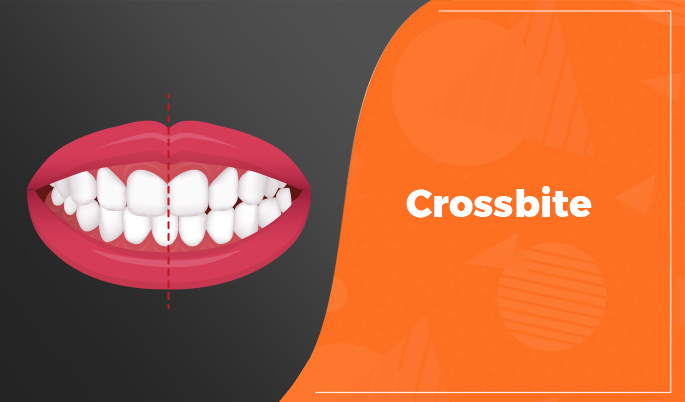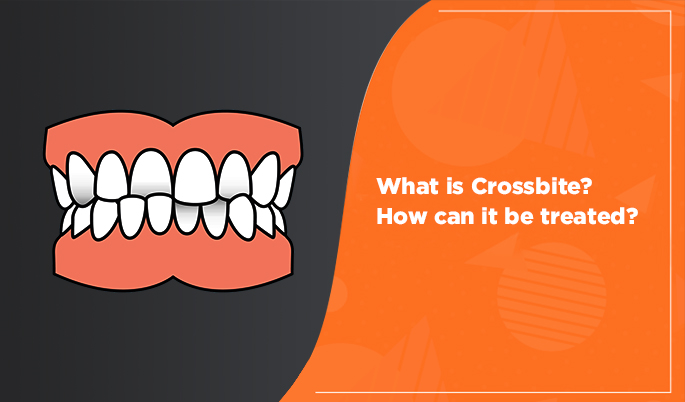What is Crossbite? How can it be treated?
Crossbite is a dental issue affecting all ages. You may not have heard about crossbite before, and while your dentist’s explanation may be a little hard to understand, we are here to give you all the relevant information related to crossbite teeth.
What is Crossbite?

A crossbite is one of the types of malocclusions or teeth misalignments which is characterized by upper teeth that fit inside the lower teeth. In a properly aligned bite, the upper set of teeth should be wider and lay on the outside of the bottom teeth. A crossbite can affect a single tooth or group of teeth, and it can involve either the front teeth, back teeth, or both.
There are various reasons why crossbite happens right from childhood, including:
- When normal tooth eruption is delayed.
- Abnormal eruption of the new teeth means that they don’t grow in place properly which results in misalignment problems.
- Most of the time crossbites are a result of genetics meaning if a parent had issues with their bites, it increases the chance of their children having issues with a crossbite too.
- Habits such as Chewing nails, finger sucking, lip sucking, or always carrying a pacifier around in the mouth may also cause crossbite teeth in children.
What are the different types of crossbites?
There are two main types of Crossbite teeth:
- Anterior Crossbite
This condition is also known as an underbite. Generally, the upper teeth fit outside the lower teeth. If an upper front tooth/teeth sit on the inside of a lower front tooth/teeth an anterior crossbite is present.
- Posterior Crossbite
Like the name says, they affect the teeth at the back. In this case, the top teeth sit inward of the bottom teeth when they should rest a bit over them. Technically speaking, upper molars should slightly overlap the lower ones always.
What happens if I don’t get crossbite treatment?
Unfortunately, once a crossbite develops, it does not resolve itself and only goes away with proper orthodontic treatment. It is mostly considered to be a cosmetic problem by people; however, the truth is it affects more than just the look of your smile. Some of the complications that can arise include:
– Poor quality of sleep
– Inability to bite or chew properly
– Speech impediments
– Deformed jawline
– An odd-looking smile
– Low self-esteem
– Temporomandibular joint disorder
– Teeth wearing out faster than normal
– Gum disease that leads to bone loss
What are my crossbite treatment options?
Luckily, most kinds of crossbites can be fixed with the right orthodontic treatment. The most popular options for crossbite correction are:
- Braces
A common treatment method of treating a crossbite is by using braces. Braces work by applying pressure on the tooth, and slowly moving it into the correct placement.
- Palate Expansion
In more severe cases of crossbite, palate expansion can be used. It helps to widen the roof of the mouth by applying gradual pressure on both sides of the upper jaw. As the palate expands, more space is created for teeth to shift into place.
- Jaw Surgery (in combination with Orthodontic treatment)
In some rare cases, jaw surgery could also be required to correct an extremely severe case of crossbite. However, oral surgery is usually reserved for the most complex orthodontic cases and only when the upper and lower jaws do not and cannot fit together.
- Clear Aligners
For mild cases of a crossbite tooth, clear aligners such as Flash Clear Aligners may be used to shift teeth into their proper position little by little. Flash Aligners cover the entire surface of the teeth, allowing a tooth in crossbite to move freely without being affected by or affecting opposite teeth.
Your best bet is to visit a trained orthodontic specialist who is an expert at straightening teeth and aligning the jaws. They will help determine which treatment is best for you.
Why Clear Aligners?
Most types of crossbite teeth can be treated by clear aligners. These invisible braces are better than all other traditional forms of dental appliances.
- Invisible
Never again do you have to be embarrassed about getting your teeth fixed. These clear ‘invisible’ aligners give you the freedom to get a smile makeover without anyone noticing it.
- Removable
The best part of clear aligners is the fact that they can be revived and worn easily. Although, to get the best results it is highly recommended that you wear them for at least 22 hours.
- Faster Results, Lesser Visits
While a minor crossbite may take only three months to correct, severe cases may last for up to 18 months. This is still better than other forms of dental appliances. Also, clear aligners require lesser visits to the orthodontist.
Proudly engineered in India, Flash Clear Aligners are customized according to every patient’s case. Made using the award-winning TRIOS intraoral scanning technology, these dental appliances give you an experience like no other. Visit your nearest Flash Orthodontist to start your Flash Aligner Treatment.

Most Recent
Difference Between Overjet and Overbite
 3-Feb-2023
3-Feb-2023
How To Fix Gap in Front Teeth?
 3-Feb-2023
3-Feb-2023
Snaggletooth: Causes and Treatments Options
 3-Feb-2023
3-Feb-2023
How to Overcome Dental Anxiety Forever?
 3-Feb-2023
3-Feb-2023

